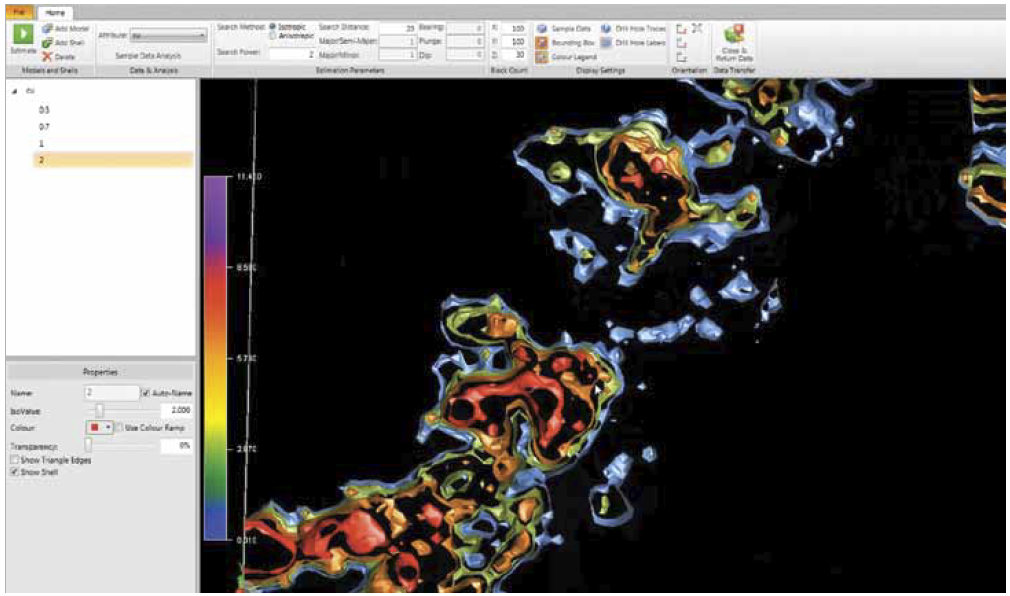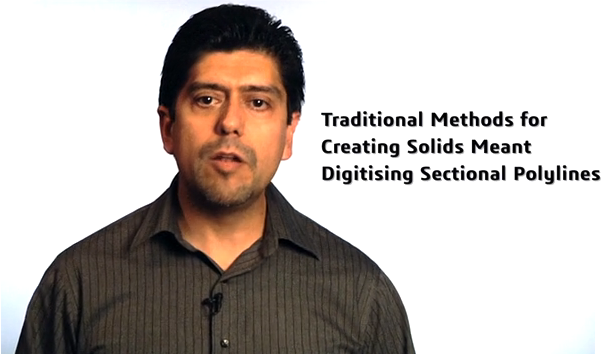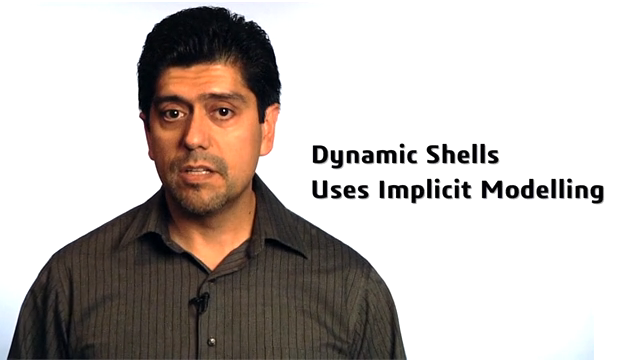Last week, Gemcom announced that the 2013 update to their Surpac software will contain a module called Dynamic Shells, which is described as a 'fast implicit modeller'. I only found this out when I received an enthusiastic email from a long-time Leapfrog customer and client of mine who told me that he's already requested a trial copy of the software from Gemcom. He's excited because he's also is a long-time Surpac user and uses Surpac much more than Leapfrog. He mistakenly thought this was a new Leapfrog product made as a plug-in for Surpac. Excellent marketing, Gemcom, if you're able to convince an occasional Leapfrog user!
It appears that Gemcom has developed something that, to the uninitiated, very much resembles Leapfrog software and that seems to compete directly with Leapfrog. But will Gemcom be able to unseat Leapfrog's implicit modelling standard and leadership by releasing this new product?

So, how revolutionary is this new competition to Leapfrog?

Curiously, in the introductory promotional video of Dynamic Shells, José Santos (Product Line Manager, Surpac and GEMS) explains that the traditional process of digitising models in sections:
"...can take hours to days simply to investigate the geometry of a potential deposit".
No kidding José!!
Some of us have been building implicit geological models with Leapfrog without a single digitised sectional polyline for ten years now and have modelled hundreds of deposits, so Gemcom is a decade behind in waking up to this idea.
Does this sudden change of attitude mean that Gemcom has finally realised that sectional digitisation is a complete waste of time and we need to convince the minerals industry to abandon the practice?
Not exactly....
Gemcom and Surpac have spent many years improving their sectional modelling methods, so they aren't likely to suddenly abandon this strategy because of a small plug-in.
Gemcom’s marketing material states that Dynamic Shells:
"Provides geometric guidance to traditional (manual) solid/polygon modelling and grade control geologists"
This sounds as though sectional digitisation is not going away (at least not for Gemcom), and that the Dynamic Shells module is to be used to guide the geologist. This philosophy reminds me of geologists who use Leapfrog, then do the 'real' modelling in a general mining software package such as Surpac. Such a strategy makes me laugh and cry at the same time as it's completely unnecessary and a waste of time. Leapfrog is also capable of robust geological modelling for the benefit of resource modelling and exploration, and it sounds as though Dynamic Shells is simply a pretend Leapfrog.

It will be interesting to see how Dynamic Shells works in real-life situations and to see whether it is a real technical competitor to Leapfrog, or just a clever use of techno jargon to confuse the uninformed. Many of my clients with Surpac will be comparing this new software with Leapfrog, and what's most interesting is that Gemcom claims that Dynamic Shells is an implicit modelling method. I will be examining this claim in a detailed review of their product in the future.
I'm taking a wild guess here, but what they appear to be showing in their promotional movie is a grid-based display of already saved grade isosurface boundaries. These isosurfaces are not being generated on the fly, but was prepared in a fine grid by interpolating the grade values using something like inverse distance interpolation. Once results are saved as a grid, it is easy to use slide bars and peel back lower grade shells. Nothing remarkable, and the technology to do this has been around for donkey's years, but with larger space for large grids, and faster graphic chips for display, this type of rendering is now possible. If my intuition is correct this is nothing like Leapfrog where the software generates isosurfaces from a continuous volume function, and not from an enormous grid.
If Gemcom's data is saved in a grid and there is no underlying volumetric function representing the grade distribution, then they have not developed an implicit modeller
I will discuss the real power of true implicit modelling in the future, but one of the most remarkable application of implicit modelling is that Surpac-style nested block models that preserves fine detail can be generated directly from drillhole data on the fly without the need for generating wireframes. Only a true implicit modeller can do this, but I will outline in a future post how to tell the difference between a real implicit modeller from a fake one.
For the unsophisticated Leapfrog user, Dynamic Shells and Leapfrog are effectively identical!
My Surpac-Leapfrog user contact had this take on this new product from Gemcom:
"Dynamic Shells may get more traction [than Leapfrog] just because it is related to Surpac and [will] leverage off their users. Will have to see what the pricing is too."
For the unsophisticated Leapfrog user (the majority, unfortunately!) and for industry professionals who are completely ignorant of Leapfrog or implicit modelling, this Dynamic Shells product will be a viable alternative to Leapfrog software. For those who remember it, the VHS and Betamax video war of the 1970s taught us that a product does not have to be technically superior (which Betamax was) to win the major share of the market.
At first glance, Dynamic Shells appears to be the technically inferior 'VHS equivalent' of the minerals industry, but if the price is right and the capabilities of Dynamic Shells 'sort of' emulate what Leapfrog does, Gemcom may well fool the majority of the market. Why would mining companies pay thousands of dollars a year in extra fees for the occasional use of Leapfrog, when it appears they can get something similar in Dynamic Shells? As Gemcom's marketing material states, the users of the Dynamic Shells module will not have to leave Surpac, so no more exporting and importing results back---that's a clear advantage to Surpac fans. It would be a no-brainer choice for those who already use Surpac to switch to this new product from Gemcom even if they are using Leapfrog now. Bean counters and IT managers would also love this, no matter what the hardcore Leapfrog users say. One software, one price, one invoice.
The best part of all this is competition...
One thing is for sure -- competition is great for users and the industry alike, so this new product from Gemcom is a welcome change for the better. Having introduced implicit modelling to the minerals industry a decade ago, it’s good for me to see that ideas that I formulated all those years ago are finally catching on in the resource industry and leading to some drastically needed changes. I think the biggest uptake and change in the geological modelling practices will come over the next decade, especially if competition such as this continues. More competition is over the horizon, as Maptek has been working on something like Leapfrog internally for years without much success, and Micromine is also working on their own version of an implicit modeller.
Until now, Leapfrog hasn't really had any viable competition. Although Geomodeller was available as an alternative implicit modelling tool, it was not really able to do what the mining industry wanted to do, so it didn't provide real competition. Geomodeller was never designed from a mining industry perspective, and that is reflected in the capabilities (or lack of them) of the software.
Gemcom’s Dynamic Shells product, on the other hand, will change this landscape, regardless of whether it can match Leapfrog’s technical capabilities. To many people in the industry, Dynamic Shells will seem very similar to Leapfrog, and ARANZ Geo (the makers of Leapfrog) will have to work much harder to differentiate their product from Gemcom’s. Only high-end users of Leapfrog like me will be able to simply and effectively demonstrate the advantages of Leapfrog---and even then, it's not really about the software but about how we apply Leapfrog to solve real mining industry issues. Similarly, ARANZ Geo will now have to demonstrate the differences between their flagship product and Gemcom’s Dynamic Shells in a tangible and practical way, which they have not had to do in any serious way in the past. Without their former business partner (SRK Consulting), this will be a tough call for them, especially as they are up against Gemcom who have decades of mining software---and software marketing---experience. (Trivia alert! - Did you know that Gemcom software and Leapfrog both originated from ideas developed in SRK Consulting? It's a little ironic that they are competing head to head!)
It will be an interesting decade ahead, but what of the question "Will Leapfrog become a Leaped Frog?"
From a technological point of view, I doubt very much that Dynamic Shells will be able to match Leapfrog's capabilities. Back in 2001, when I proposed the SRK-ARANZ alliance to develop Leapfrog using ARANZ's interpolation engine, I did my due diligence and found that there was little chance that anyone at the time could come up with anything similar to what ARANZ had already developed. Based on my assessment, SRK Consulting Australia invested in the development of Leapfrog software. Much of the logic written into Leapfrog for geological modelling is founded on well-established structural geological principles, many of which I still have not published. From what I can gather, where Gemcom is at today with Dynamic Shells, does not come close to the state of technology and understanding we had back in 2001.
However, from a marketing perspective Gemcom clearly has the upper hand over ARANZ, and with clever marketing, they can easily knock Leapfrog off its perch. Whether Dynamic Shells actually works like Leapfrog is a moot point. It doesn't really matter, because in marketing it's all about perception and using clever weasel words to convince the market. With the large Surpac user base, Gemcom has immediate access to a big network of potential buyers. And with a convincing monetary argument to the IT and accounting people in the mining industry, it may be very hard for Leapfrog users to convince their companies to remain with Leapfrog.
We live in interesting times!